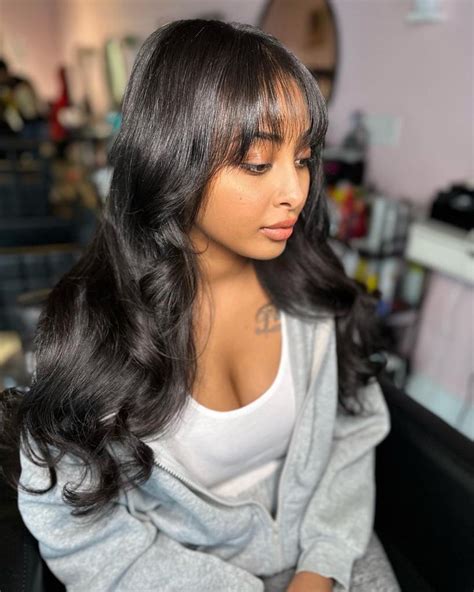What are Hair Sew Ins?
Hair sew ins are a method of hair extensions that involve attaching artificial or natural hair to your natural hair using a needle and thread. The hair extensions are sewn onto cornrows or braids that are created close to the scalp, providing a seamless and secure bond.

Types of Hair Sew Ins
1. Machine Sewn:
- Uses a sewing machine to secure the extensions to your natural hair.
- Provides a fast and efficient process, but requires special equipment.
2. Hand Sewn:
- Sews the extensions in by hand using a needle and thread.
- Offers more precision and customization, but is more time-consuming.
3. Micro-Braids Sew In:
- Involves creating tiny braids in your natural hair and sewing the extensions directly onto these braids.
- Creates a more natural and realistic blend, but is more delicate.
Benefits of Hair Sew Ins
- Versatility: Allows you to add length, volume, or color to your natural hair.
- Protective: Shields your natural hair from damage caused by heat styling or chemical treatments.
- Low Maintenance: Requires minimal styling and upkeep compared to other extensions.
- Long-Lasting: Can last up to 8 weeks with proper care.
- Customizable: Can be tailored to suit your desired length, thickness, and texture.
Choosing the Right Hair Sew Ins
1. Hair Type:
- Natural Hair: Match the texture and color of your extensions to your natural hair to achieve a seamless blend.
- Artificial Hair: Synthetic extensions are available in a wide range of colors and textures, offering more versatility.
2. Length:
- Consider the desired length of your extensions and your natural hair’s length.
- Too long extensions can appear unnatural, while too short extensions won’t provide the desired impact.
3. Thickness:
- Choose extensions that provide the desired volume and thickness.
- Thin extensions may lack impact, while excessively thick extensions may overwhelm your natural hair.
4. Quality:
- Opt for high-quality extensions that are made from durable materials and are less likely to tangle or shed.
How to Apply Hair Sew Ins
Step-by-Step Guide:
1. Prepare Your Hair:
- Wash and condition your natural hair to remove any dirt or products.
- Part your hair into sections and braid or cornrow close to the scalp.
2. Sew in the Extensions:
- Using a needle and thread, sew the extensions onto the braids starting from the nape of the neck.
- Ensure the extensions are sewn on securely without causing tension or discomfort.
3. Style Your Hair:
- Once the extensions are in place, style your hair as desired.
- Blend the extensions with your natural hair using a curling iron or straightener.
How to Care for Hair Sew Ins
- Regular Washing and Conditioning: Wash and condition your sew ins regularly using sulfate-free products.
- Avoid Excessive Heat Styling: Limit the use of heat styling tools as they can damage the extensions.
- Brush Your Hair Regularly: Brush your hair gently using a wide-tooth comb or detangling brush.
- Sleep with a Silk Scarf: Cover your hair with a silk scarf at night to prevent tangles and breakage.
- Get Regular Maintenance: Visit a professional stylist every 4-6 weeks for maintenance and touch-ups.
Pros and Cons of Hair Sew Ins
Pros:
- Long-lasting
- Versatile
- Protective
- Customizable
- Low maintenance
Cons:
- Can be expensive
- Requires professional installation and maintenance
- May damage natural hair if not applied correctly or overused
- Can be uncomfortable to sleep on
Creative Applications of Hair Sew Ins
1. Ombre or Balayage: Create a gradual color transition by sewing in extensions of different colors.
2. Faux Bob: Get the illusion of a shorter haircut by adding sew-in extensions to the nape of the neck.
3. Undercut Illusion: Sew in extensions to the sides of your head to create the appearance of an undercut.
4. Hair Cuffs: Attach extensions to your natural hair using hair cuffs for a semi-permanent pop of color or texture.
Tables for Easy Comparison
Table 1: Types of Hair Sew Ins
| Type | Method | Pros | Cons |
|---|---|---|---|
| Machine Sewn | Uses a sewing machine | Fast, efficient | Requires special equipment |
| Hand Sewn | Sews in by hand | Precise, customizable | Time-consuming |
| Micro-Braids Sew In | Sews onto tiny braids | Natural, realistic | Delicate |
Table 2: Factors to Consider When Choosing Hair Sew Ins
| Factor | Considerations |
|---|---|
| Hair Type | Match texture and color to your natural hair |
| Length | Consider desired length and natural hair’s length |
| Thickness | Choose extensions that provide desired volume |
| Quality | Opt for durable, high-quality extensions |
Table 3: Pros and Cons of Hair Sew Ins
| Pros | Cons |
|---|---|
| Long-lasting | Expensive |
| Versatile | Requires professional installation and maintenance |
| Protective | May damage natural hair if not applied correctly or overused |
| Customizable | Can be uncomfortable to sleep on |
| Low maintenance |
Table 4: Creative Applications of Hair Sew Ins
| Application | Description |
|---|---|
| Ombre or Balayage | Gradual color transition using different colored extensions |
| Faux Bob | Shorter haircut illusion with extensions at the nape of the neck |
| Undercut Illusion | Extensions at the sides of the head to create an undercut appearance |
| Hair Cuffs | Semi-permanent pop of color or texture using extensions attached with hair cuffs |
Conclusion
Hair sew ins are a versatile and effective way to enhance your natural hair. By choosing the right type, length, and thickness, you can achieve the desired look that suits your individual needs and preferences. With proper care and maintenance, hair sew ins can provide long-lasting results and elevate your hairstyle to new heights.
